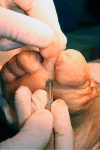Clinical outcome after percutaneous flexor tenotomy in forefoot surgery
- PMID: 19224211
- PMCID: PMC2899099
- DOI: 10.1007/s00264-009-0721-5
Clinical outcome after percutaneous flexor tenotomy in forefoot surgery
Abstract
The aim of this study was to evaluate the outcome of the percutaneous flexor tenotomy. We compared the results of two groups. The first group included 23 patients who underwent forefoot surgery without percutaneous flexor tenotomy, and the second group included 50 patients who underwent the same procedure combined with percutaneous flexor tenotomy for claw toe deformities, secondary to shortening metatarsal Scarf osteotomy. The average follow-up was 11.6 months. Three algoneurodystrophies were noted. No delayed wound healing was observed. Functional dissatisfaction rate (18% vs.17.4%) and toe pulp contact defect (12% vs. 8.7%) were not significantly different in the two groups. Toe grasping defect rate (10% vs. 4.3%) was superior in the tenotomy group. Five recurring claw toe deformities of the second toe were noted in the tenotomy group. Percutaneous flexor tenotomy is a simple, rapid, and efficient method to correct reducible secondary claw toe deformities. However, despite a significant postoperative loss of toe grasping function, no patient reported major dissatisfaction.
Devenir clinique après ténotomie percutanée des tendons fléchisseurs des orteils dans la chirurgie de l’avant pied. Le but de cette étude était d’évaluer le devenir de la ténotomie percutanée du fléchisseur. Nous avons comparé les résultats de deux groupes, le premier sous-groupe incluant 23 patients ayant bénéficié d’une chirurgie de l’avant pied sans ténotomie percutanée du fléchisseur et le second, incluant 50 patients, ayant bénéficié de la même chirurgie associée à une ténotomie percutanée du fléchisseur pour une déformation des orteils en marteau ou en griffe, secondaire au raccourcissement métatarsien après ostéotomie de Scarf. Le suivi moyen a été de 11,6 mois. Trois algoneurodystrophies ont été rapportées. Aucun défaut de cicatrisation n’a été observé. Le taux d’insatisfaction est de 18% (vs 17,4%) et le défaut d’appui pulpaire du gros orteil de 12% (vs 8,7%), ces taux ne sont pas significativement différents dans les deux groupes. Le taux de défaut d’aggrippement des orteils est supérieur de manière significative dans le groupe avec ténotomie (10% vs 4,3%). Cinq récidives de griffes du deuxième orteil ont été rapportées dans le groupe ténotomie. La ténotomie percutanée du fléchisseur est un geste simple, rapide et efficace permettant de corriger les déformations secondaires en griffes des orteils. Cependant, malgrè l’existence d’un défaut d’aggripement des orteils postopératoire, aucun patient n’a rapporté d’insatisfaction majeure.
Figures
Similar articles
-
The impact of associated tenotomies on the outcome of incomplete phalangeal osteotomies for lesser toe deformities.J Orthop Surg Res. 2019 Sep 11;14(1):308. doi: 10.1186/s13018-019-1353-0. J Orthop Surg Res. 2019. PMID: 31511051 Free PMC article.
-
[Scarf osteotomy for the treatment of forefoot deformity].Acta Chir Orthop Traumatol Cech. 2006;73(1):18-22. Acta Chir Orthop Traumatol Cech. 2006. PMID: 16613743 Czech.
-
The results of Scarf osteotomy combined with distal soft tissue procedure are mostly satisfactory in surgical management of moderate to severe hallux valgus.Foot Ankle Surg. 2018 Oct;24(5):448-452. doi: 10.1016/j.fas.2017.05.001. Epub 2017 May 29. Foot Ankle Surg. 2018. PMID: 29409200
-
[Minimally invasive correction of lesser toe deformities and treatment of metatarsalgia].Oper Orthop Traumatol. 2018 Jun;30(3):171-183. doi: 10.1007/s00064-018-0548-6. Epub 2018 May 8. Oper Orthop Traumatol. 2018. PMID: 29737368 Review. German.
-
Minimally invasive and percutaneous surgery of the forefoot current techniques in 2018.Eur J Orthop Surg Traumatol. 2018 Jul;28(5):819-837. doi: 10.1007/s00590-018-2137-7. Epub 2018 Mar 24. Eur J Orthop Surg Traumatol. 2018. PMID: 29574577 Review.
Cited by
-
The impact of associated tenotomies on the outcome of incomplete phalangeal osteotomies for lesser toe deformities.J Orthop Surg Res. 2019 Sep 11;14(1):308. doi: 10.1186/s13018-019-1353-0. J Orthop Surg Res. 2019. PMID: 31511051 Free PMC article.
-
The pathology and management of lesser toe deformities.EFORT Open Rev. 2017 Mar 13;1(11):409-419. doi: 10.1302/2058-5241.1.160017. eCollection 2016 Nov. EFORT Open Rev. 2017. PMID: 28461920 Free PMC article. Review.
References
-
- Coillard JY, Laffenetre O. Distal percutaneous metatarsus osteotomy: surgical procedure and preliminary results. Rev Chir Orthop App Mot. 2004;6S90:120.
-
- De Prado M, Repoll PL, Golano P (2003) Metatarsalgias. In: Masson (ed) Cirugia percutanea del pie. Barcelona, 165–174
-
- Coughlin MJ. Lesser toe abnormalities. Instr Course Lect. 2003;52:421–444. - PubMed
Publication types
MeSH terms
LinkOut - more resources
Full Text Sources


